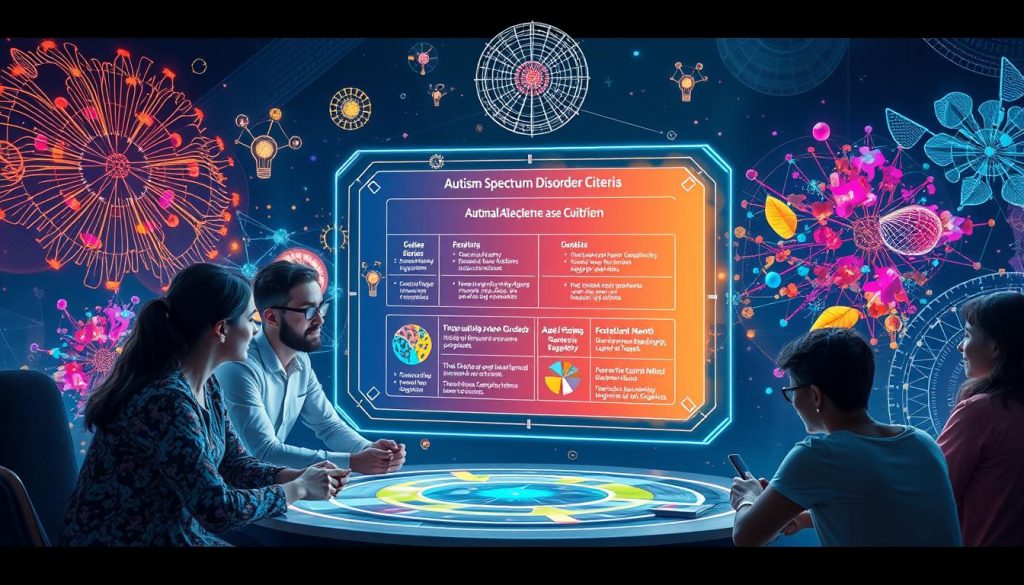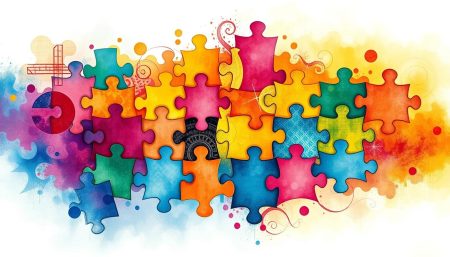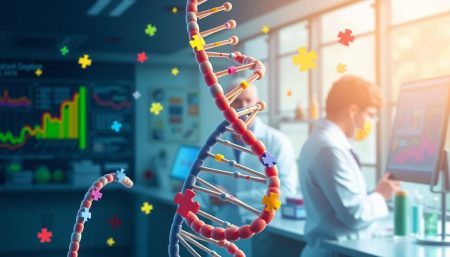The American Psychiatric Association has updated the Diagnostic and Statistical Manual of Mental Disorders, known as the DSM-5. This update changes the criteria for autism spectrum disorder (ASD) to make diagnosis more accurate. The DSM-5 makes the autism diagnosis criteria more precise than before.
This change is important for doctors, teachers, and families. It helps ensure that people get the right help they need. The DSM-5 reflects new knowledge and understanding of autism.
Using the DSM-5 autism criteria correctly is key. It requires understanding the new rules and how they affect treatment. Many sources, like research papers, help professionals understand and apply these changes.
These updates aim to improve how we diagnose and treat autism. They help us see the unique needs of each person with ASD. This ensures that everyone gets the care they deserve.
Understanding Autism Spectrum Disorder in the DSM-5
The DSM-5 (Diagnostic and Statistical Manual of Mental Disorders, Fifth Edition) has made diagnosing autism spectrum disorder (ASD) easier. It has updated the criteria for diagnosing ASD. This helps doctors diagnose ASD in a more consistent way, across different ages and symptoms.
The DSM-5 has broadened the definition of autism. It combines several disorders into one category: Autism Spectrum Disorder. This change helps recognize the wide range of abilities and symptoms in people with ASD. It focuses on challenges in social communication and repetitive behaviors.
The DSM-5 also introduces a tiered severity scale for ASD. This scale helps doctors tailor treatments to each person’s needs. Here are the key diagnostic criteria and characteristics of ASD as outlined by the DSM-5:
- Persistent deficits in social communication and social interaction across multiple contexts.
- Restricted, repetitive patterns of behavior, interests, or activities.
- Symptoms must be present in the early developmental period (but may not fully manifest until social demands exceed limited capacities, or may be masked by learned strategies in later life).
- These disturbances are not better explained by intellectual disability or global developmental delay.
This approach makes diagnosing ASD simpler. It also shows that ASD is a complex disorder that affects each person differently. The DSM-5’s criteria have been key in improving both treatment and research for ASD.
Core Features of Autism Spectrum Disorder in DSM-5
The DSM-5 lists key signs of autism spectrum disorder (ASD). These signs help doctors and researchers spot and diagnose autism. They are key to identifying ASD and guide the diagnosis process.
Defining Social Communication and Interaction
ASD is marked by big challenges in talking and interacting with others, as the DSM-5 says. People with ASD might find it hard to share feelings, start or keep up conversations, and keep friends. Doctors look for these signs over time to see how they affect someone’s life.
For example, kids and adults with ASD might not get body language or facial expressions. This makes it hard for them to understand social clues. This is a key sign of autism, as seen in the DSM-5, and needs careful checking to tell it apart from other social issues.
Understanding Restricted, Repetitive Patterns of Behavior
The DSM-5 also talks about repetitive behaviors or interests in ASD. These can be things like repeating movements, sticking to routines, or having very focused interests. These interests are often too intense or focused.
Doctors need to watch these signs closely, often in different places and from many people. Seeing these behaviors helps doctors understand the person’s challenges better. This leads to more specific help and support.
It’s important to know about autism’s core features and how they are checked at all ages. This ensures people with ASD get the right diagnosis and care. By following the DSM-5’s detailed rules, doctors can give a reliable diagnosis. This helps shape how we treat and support people with autism.
Autism Diagnosis Criteria in DSM-5
The DSM 5 autism spectrum disorder criteria outline a detailed framework. It aims to identify persistent social communication and interaction deficits. It also looks for restricted, repetitive behaviors or interests. These symptoms must be present from early childhood and impact daily life.
The DSM 5 autism spectrum disorder diagnosis process involves a thorough assessment. Healthcare professionals observe and gather reports from parents or caregivers. The disorder must significantly impair personal, social, academic, or occupational functioning to meet the DSM-5 criteria.
Excluding other developmental disorders is key to avoid misdiagnosis. Clinicians must differentiate autism from other DSM-5 developmental disorders. This ensures an accurate diagnosis and proper intervention plans.
- Persistent deficits in social communication and social interactions.
- Restricted, repetitive patterns of behavior, interests, or activities.
- Symptoms must be present in the early developmental period.
- Symptoms together cause significant impairment in important areas of functioning.
- Disturbances are not better explained by intellectual disability or global developmental delay.
The severity assessment within the dsm 5 autism spectrum disorder criteria is vital. It determines the level of support needed. It is categorized into three levels:
- Level 1: “Requiring support”
- Level 2: “Requiring substantial support”
- Level 3: “Requiring very substantial support”
Studies show the DSM-5 criteria cover a broader spectrum of autism disorders. This might lead to more diagnoses. But, it also means earlier treatment, which could improve outcomes. Healthcare professionals should use the criteria carefully to ensure accurate and personalized diagnoses.
DSM 5 Autism Spectrum Disorder Diagnosis Process
The process for diagnosing Autism Spectrum Disorder (ASD) under the DSM 5 is detailed and involves many experts. It starts with a first screening. Then, it uses different tools and the work of several professionals for a full autism spectrum disorder assessment.
Psychologists, psychiatrists, and speech-language pathologists are key in this process. They each play a big role in checking if someone meets the dsm 5 autism criteria. This team makes sure all parts of ASD are looked at and the diagnosis is right and complete.
During the check, tools and interviews that follow DSM-5 rules are used. Also, reports from parents and the person themselves are very important. They help show the person’s growth and current signs.
- Initial Screening: Quick checks to identify early signs of ASD.
- Detailed Diagnostic Evaluations: Complete checks to confirm ASD against DSM-5 criteria.
- Interdisciplinary Feedback: Contributions from various specialists to form a conclusive diagnosis.
Getting the DSM-5 criteria right needs a lot of skill and ongoing learning about ASD. The table below shows some tools and methods used in this detailed process:
| Diagnostic Tools | Type of Assessment | Role in Diagnosis |
|---|---|---|
| ADOS (Autism Diagnostic Observation Schedule) | Observational | Main tool for assessing communication, social interaction, and play |
| ADI-R (Autism Diagnostic Interview-Revised) | Interview | Structured parental interview to collect developmental history |
| Cognitive and language assessments | Performance-based | Evaluates cognitive and language abilities essential for differential diagnosis |
This careful and important process makes sure each Autism Spectrum Disorder diagnosis is as correct as it can be. It helps start the right treatment plans for each person.
Autism Symptoms in DSM 5: What to Look Out For
Understanding the autism spectrum disorder diagnostic criteria is key when dealing with Autism Spectrum Disorder. This guide explains how to spot symptoms in different age groups. Knowing this can greatly help in getting the right support and care.
Recognizing Early Signs of Autism in Children
Finding early signs of autism in kids is vital for early help. Look for signs like delayed speech, less interest in social activities, or odd play. These signs match what the DSM-5 says. Spotting these early helps in using special education and behavior plans to improve their growth.
Identifying Autism Symptoms in Adults
Autism in adults can be harder to spot and more complex. It might show as trouble understanding social hints, strict thinking, or being very sensitive to sounds and sights. These signs can also look like other mental health issues, making it tough to diagnose. It needs a deep understanding of the autism spectrum disorder diagnostic criteria.
Spotting signs in kids and adults is key for good support and care. It helps not just the person but also their family and community. This shows how important it is to know about autism and its effects.
Changes from DSM-IV to DSM-5 for Autism Spectrum Disorder
The move from DSM-IV to DSM-5 brought big changes in how we diagnose autism spectrum disorder. This change shows a deeper understanding and a move towards a more inclusive approach. The dsm 5 criteria for autism now combines several old categories into one, making diagnosis clearer and treatment more effective.
The decision to remove Asperger’s Syndrome as a separate category has sparked a lot of debate. This change aims to better match the broader spectrum view of autism. It brings both challenges and benefits to how we support people with ASD.
Adding sensory issues to the diagnostic criteria has been a key change. Now, sensory sensitivities are officially part of the criteria. This change recognizes their big impact on daily life and social interactions for those with ASD.
Here’s a quick look at how autistic disorder classifications have changed from DSM-IV to DSM-5. This helps us see how the way we diagnose has shifted.
| Criteria/Features | DSM-IV | DSM-5 |
|---|---|---|
| Diagnostic Categories | Autistic Disorder, Asperger’s Disorder, PDD-NOS | Autism Spectrum Disorder |
| Symptom Domains | Social Interaction & Communication; Restricted, Repetitive Patterns of Behavior | Social Communication; Restricted, Repetitive Patterns of Behavior |
| Inclusion of Sensory Issues | No | Yes |
The updates to dsm 5 autism spectrum disorder criteria also affect how many people are diagnosed and what services they get. These changes have been studied to fully understand their effects.
It’s important to keep researching and talking about these changes in the dsm 5 autism spectrum disorder framework. This ensures that the changes help meet the needs of all those affected and their communities.
Case Studies: Diagnosing ASD with DSM-5 Criteria
In clinical practice, using DSM-5 criteria for diagnosing Autism Spectrum Disorder (ASD) shows the need for a detailed approach. This approach must fit the complex symptoms each person shows. We will look at several case studies to see how these criteria and assessments work together.
These case studies come from thorough checks by experts. They use the DSM-5 criteria to understand each person’s behavior and past. These examples show how different ASD can be and how important it is to judge each case carefully.
Understanding these case studies also means recognizing the challenges in assessing ASD. It’s key to see how different symptoms of ASD lead to different diagnosis and treatment plans.
| Case No. | Presenting Symptoms | Assessment Method | Outcome |
|---|---|---|---|
| 1 | Severe communication difficulties, repetitive behaviors | Clinical observation and standardized tests | Comprehensive behavioral intervention plan |
| 2 | Mild social interaction challenges, strong verbal skills | Parent interviews, direct assessment | Targeted social skills training |
| 3 | Nonverbal, sensory sensitivities | Multi-disciplinary evaluation | Integration of sensory integration therapy |
Looking at these examples, we see the need for a flexible approach in assessing ASD. Each diagnosis, based on DSM-5 criteria, leads to a treatment plan that fits the individual. This shows how important it is to be precise in both diagnosis and treatment.
Together, these case studies highlight the value of learning from real-life examples. They offer key insights for improving education and developing better diagnostic skills for ASD.
Evaluating the DSM-5 Autism Spectrum Disorder Criteria
The DSM-5 has changed how we diagnose autism spectrum disorder. It brought new criteria that started many discussions. People from all walks of life talked about the dsm 5 autism spectrum disorder criteria.
Controversies Surrounding the DSM-5 ASD Criteria
Many argue that the new criteria don’t cover all autism symptoms. They say it might miss some people who were diagnosed before. This change worries those who need help and could affect how much money is spent on services.
The Impact of DSM-5 Criteria on Diagnosis and Treatment
The DSM-5 criteria aim to make diagnosis better. Supporters say it helps find autism earlier and more accurately. This is key for helping people with autism do well in life.
Also, the dsm 5 autism spectrum disorder criteria have led to better treatments. These new treatments might help people with autism more than before.
| Aspect | Impact of DSM-5 Criteria | Previous DSM-IV Criteria |
|---|---|---|
| Diagnostic Accuracy | Increased specificity | Broader, more inclusive |
| Prevalence Rates | Potential decrease | Higher reported rates |
| Access to Services | May be limited for some | Broad eligibility |
| Intervention Strategies | More targeted approaches | Generalized approaches |
Autism Spectrum Disorder Assessment Techniques
The autism spectrum disorder assessment process is complex. It uses many tools and techniques. These tools help check cognitive, communicative, social, and behavioral areas. They follow the autism spectrum disorder DSM 5 criteria closely.
Observational assessments are a key method. Trained professionals watch the individual in different places. This helps see if behaviors are the same everywhere.
Structured interviews are also important. They talk to the individual, family, and teachers. This gives a full view of the person’s strengths and challenges.
Standardized tests are vital too. They are made to fit the unique needs of those with ASD. They check important skills and behaviors. This is all based on the autism spectrum disorder DSM 5 guidelines. Here are some of these tools:
| Assessment Tool | Focus Area | Compatibility with DSM-5 |
|---|---|---|
| ADOS-2 | Social Interaction, Communication | High |
| Vineland-3 | Daily Living Skills | High |
| Bayley-3 | Cognitive Abilities | Moderate |
It’s key to have experts who know autism spectrum disorder DSM 5 well. This makes the assessment detailed and right for the person.
Cultural and linguistic considerations are very important. A culturally aware assessment avoids mistakes due to cultural or language differences. Using many tools and thinking about these factors helps give a correct and helpful diagnosis. This opens the door to good treatment plans.
DSM 5 Autism Spectrum Disorder Criteria and Schooling
The dsm 5 autism spectrum disorder criteria change how schools teach students with autism. These criteria help make educational plans that fit each student’s needs.

Using the dsm 5 autism criteria in schools helps teachers and doctors work together better. This teamwork makes sure students with ASD get the right support. It’s key for placing students in the right classes and getting them the help they need.
- Educational Programming: Individualized Education Plans (IEPs) are made based on dsm 5 autism criteria. This makes sure teaching methods match each student’s abilities and needs.
- Special Education Classification: Using DSM-5 criteria helps place students correctly in special education. This is the first step to getting the right support and services.
- Access to Academic Accommodations: Knowing a student’s needs from DSM-5 criteria helps them get the right help in school. This makes learning better for them.
Using dsm 5 autism spectrum disorder criteria in schools makes them more welcoming. This helps not just students with ASD but the whole school. It makes education better for everyone.
The changes in educational standards because of DSM-5 updates show how teaching keeps evolving. It shows the need for teachers to always learn and improve their teaching methods.
Comorbid Conditions Associated with Autism in DSM-5
In the dsm 5 autism spectrum disorder framework, it’s key to know about comorbid conditions. These are conditions that often come with autism. The DSM-5 lists ADHD, anxiety disorders, depression, and intellectual disabilities as common ones. A team effort is needed for diagnosis and treatment.
Addressing ADHD and Autism
ADHD and autism together pose big challenges. Symptoms like trouble focusing and controlling impulses are shared. The DSM-5 says it’s important to carefully check for both conditions. Treatment plans must cover both, using behavior changes and sometimes medicine.
Anxiety Disorders and ASD: What DSM-5 Reveals
Anxiety disorders often go hand in hand with autism, as the DSM-5 shows. Anxiety makes social interactions harder and increases sensitivity to sounds and sights. The DSM-5 helps doctors see these challenges together. It stresses the need for a treatment plan that tackles both autism and anxiety.
- Use of cognitive-behavioral therapy (CBT) to manage anxiety
- Integration of social skills training to improve interaction
- Regular assessments to fine-tune treatment approaches
Managing autism with ADHD and anxiety needs a complete approach. Recognizing early signs of autism and tackling these issues improves treatment success. It also boosts the quality of life for those affected.
The Role of Parents and Caregivers in the DSM-5 ASD Diagnosis
Parents and caregivers play a key role in getting a diagnosis of Autism Spectrum Disorder (ASD) under the DSM-5. The autism spectrum disorder DSM-5 framework highlights the need for a detailed autism spectrum disorder assessment. This includes input from parents on their child’s development and behaviors.
Learning about the DSM-5 criteria can be tough for families. That’s why it’s important to have resources that teach about ASD signs, diagnostic criteria, and how to assess. These resources help parents contribute to the assessment, share their child’s developmental history, and fight for their needs.
The diagnosis process can be tough emotionally for families. They face uncertainty and worry about their child’s future. But, with the right support and resources, parents and caregivers can get help and guidance after an ASD diagnosis.
| Resource Type | Description | Benefit to Parents/Caregivers |
|---|---|---|
| Educational Workshops | Events that educate about ASD symptoms, the diagnosis process, and living with ASD | Enhances understanding and preparedness for managing ASD |
| Support Networks | Groups providing emotional and practical support to families navigating ASD | Offers a community of support, reducing feelings of isolation |
| Professional Counseling | Access to mental health professionals specializing in ASD | Helps address mental health challenges and supports coping strategies |
- Parental involvement in detailed observation reporting enhances the accuracy of autism spectrum disorder assessments.
- Resource availability for parents post-diagnosis aids in adapting to lifestyle changes and advocating for their child’s educational and social needs.
So, the role of parents and caregivers is not just important but also changes the game in the autism spectrum disorder DSM-5 diagnostic process. It shapes the outcomes and support systems for the diagnosed individual.
Autism Spectrum Disorder: Incorporating DSM-5 into Therapeutic Practices
Using the dsm 5 autism spectrum disorder criteria in therapy is key. It helps mental health experts tailor care to each person. This ensures that those with ASD get plans that meet their specific needs.
How Therapists Use DSM-5 Criteria
Therapists use the dsm 5 criteria to find out what challenges and strengths each client has. This helps them identify important areas to work on. It lets them set goals that are realistic and achievable.
The criteria also help track progress and adjust treatments as needed. This makes sure the therapy is effective and meets the client’s needs.
DSM-5’s Role in Crafting Individualized Treatment Plans
Therapists use the autism spectrum disorder diagnostic criteria from DSM-5 to create personalized plans. This approach makes therapy more effective. It also shows a deep understanding of each client’s unique situation.
Many evidence-based interventions are used, thanks to DSM-5 insights:
- Behavioral therapies that focus on improving specific behaviors and developing new skills
- Social skills training to enhance interaction capabilities
- Cognitive-behavioral therapy tailored to address co-occurring anxiety and mood disorders
- Family therapy to educate and engage family members in the therapeutic process
| Intervention | Focus based on DSM-5 | Expected Outcome |
|---|---|---|
| Behavioral Therapies | Behavior Modification | Improved specific behavior patterns |
| Social Skills Training | Enhancement of Social Interaction | Greater social competence |
| Cognitive Behavioral Therapy | Managing Anxiety and Mood Disorders | Better emotional regulation |
| Family Therapy | Family Involvement and Support | Strengthened family coping strategies |
Insurance, Healthcare, and DSM-5 Autism Spectrum Disorder Criteria
The DSM-5 autism criteria have changed how insurance and healthcare deal with autism. They help decide who gets insurance benefits. This has made it easier for some to get the help they need but harder for others.
After the DSM-5 updates, families find it harder to understand insurance policies. The dsm 5 autism criteria have led to changes in insurance policies. These changes affect what autism-related services are covered.
Therapy coverage has been a big area of change. Insurance companies have made their policies more strict. Now, they decide if certain therapies are really needed based on DSM-5.
Looking at real cases and legal decisions can show how dsm 5 autism criteria affect healthcare and insurance. These examples show how DSM-5 has changed legal decisions about healthcare coverage.
| Clinical Feature | Insurance Eligibility Pre-DSM-5 | Insurance Eligibility Post-DSM-5 |
|---|---|---|
| Behavioral Therapy | Widely Covered | Coverage Based on Specific Assessments |
| Speech Therapy | Limited Coverage | Expanded Eligibility |
| Educational Support | Not Covered | Covered Under Certain Plans |
| Medication Management | Varied by Provider | More Consistent Coverage |
After DSM-5, people face many challenges. Some get more help, but others find it harder to get the care they need. They have to prove they need certain treatments.
Even with these challenges, the goal is to make care better for those with autism. Healthcare providers, insurance companies, and others are working together. They aim to make care more tailored and effective for everyone.
Current Debates and Future Directions in DSM-5 ASD Criteria
The autism spectrum disorder DSM 5 criteria are at the center of ongoing debates. These discussions cover the current methods for diagnosing autism and what the future might hold. It’s important to keep the diagnosis up-to-date with new science and societal changes.
The Evolution of Autism Criteria and Its Global Implications
The DSM-5’s update changed how we diagnose autism, affecting it worldwide. But, using these criteria globally is hard, mainly because of cultural differences and unequal access to diagnosis. This highlights the need for future criteria that work better for everyone, everywhere.
Incorporating Technological Advances in Autism Diagnosis and Assessment
New tech like artificial intelligence and machine learning is changing autism diagnosis. These tools could make diagnoses more accurate and help tailor treatments to each person. This could be a big step forward in how we help people with autism.

| Technology | Current Use | Potential Future Impact |
|---|---|---|
| Artificial Intelligence | Pattern recognition in diagnostic data | More accurate early detection and diagnosis customization |
| Machine Learning | Data analysis for behavioral prediction | Development of adaptive diagnostic tools and treatments |
| Virtual Reality | Assessment of social and cognitive skills | Immersive environments for more accurate assessment and therapy |
Autism Spectrum Disorder DSM 5: Moving Towards a More Inclusive Framework
The dsm 5 autism spectrum disorder criteria have evolved over time. This shows a deep commitment to understanding complex neurological conditions. The DSM-5 now aims to include a wider range of ASD presentations, showing the spectrum’s diversity.
Researchers, clinicians, and advocacy groups work together. They strive to make the criteria both clinically useful and true to the experiences of those with autism.
Experts have suggested ways to improve the dsm 5 autism spectrum disorder criteria. They want to account for cultural, gender-specific, and developmental differences. This would make the criteria more accurate and inclusive.
Research is helping to make these changes. The criteria are expected to become more detailed and sensitive to the variety of ASD presentations.
Feedback from the medical community and those with autism is key. This feedback makes the criteria stronger and more reflective of the autism spectrum.
Future conferences and symposia will be important for discussing and improving autism diagnosis. The goal is to keep the DSM-5 criteria up-to-date with new research and advocacy. This partnership aims to create a future where the DSM-5 truly represents the diversity of ASD.
FAQ
Q: What changes were made to the autism spectrum disorder criteria in DSM-5?
A: DSM-5 combined the old subcategories of autism into one diagnosis. It also changed how symptoms are defined. Now, sensory issues are part of the criteria.
Q: How does DSM-5 define Autism Spectrum Disorder?
A: DSM-5 says Autism Spectrum Disorder is about lasting problems with social communication and interaction. It also includes repetitive behaviors and interests.
Q: What are the core features of Autism Spectrum Disorder in DSM-5?
A: The main features are problems with social communication and interaction. There are also repetitive behaviors and interests. These must be seen in early development.
Q: How are the severity levels determined in the DSM-5 autism diagnosis criteria?
A: Severity levels are based on how much support someone needs. This is due to social communication and repetitive behaviors. Levels range from needing some support to needing a lot.
Q: What is the DSM-5 autism spectrum disorder diagnosis process?
A: A team of experts works together to diagnose. They look at the patient’s history, observe, and use tests. This is all to check if the symptoms match DSM-5 criteria.
Q: What are some early signs of autism in children according to DSM-5?
A: Early signs include delayed speech and little interest in socializing. Atypical play behaviors can also be a sign. These are signs of developmental challenges.
Q: Can adults be diagnosed with autism and what symptoms are present?
A: Yes, adults can get an autism diagnosis. They might struggle with social nuances, have rigid thinking, or be very sensitive to sensory inputs. These signs might have been missed before.
Q: How was Asperger’s Syndrome affected by the change to DSM-5?
A: Asperger’s Syndrome was once its own category. But DSM-5 merged it into the autism spectrum disorder diagnosis. This means it’s no longer a separate diagnosis.
Q: What are some case studies that illustrate the use of DSM-5 criteria in diagnosing ASD?
A: Case studies show how ASD can present differently. Clinicians use DSM-5 to understand each person’s unique situation. This helps tailor treatment plans.
Q: What controversies surround the DSM-5 ASD criteria?
A: There are debates about the criteria’s impact. Some worry it might broaden the definition of autism. This could change how many people are diagnosed and affect services.
Q: How do the DSM-5 criteria impact autism diagnoses and treatment?
A: The criteria change how we diagnose and treat autism. This can lead to new ways of helping individuals with autism.
Q: What assessment techniques are used for Autism Spectrum Disorder?
A: Assessments include watching behaviors, interviews, and tests. These evaluate cognitive, communicative, social, and behavioral areas. They follow DSM-5 guidelines.
Q: How do DSM-5 autism spectrum disorder criteria influence schooling and education?
A: The criteria affect how schools help students with autism. They can change special education plans and what services are available.
Q: What comorbid conditions are associated with autism in DSM-5?
A: Conditions like ADHD, anxiety, depression, and intellectual disability often go with autism. Treating these together is key for full care.
Q: In the DSM-5 autism diagnosis, what is the role of parents and caregivers?
A: Parents and caregivers are vital. They provide history, help with assessments, and support their child through the process.
Q: How is DSM-5 utilized in crafting individualized therapeutic practices for ASD?
A: Therapists use DSM-5 to set goals and focus areas for treatment. They create plans that fit the person’s needs and symptoms.
Q: How do DSM-5 autism spectrum disorder criteria affect healthcare and insurance?
A: The criteria help decide who gets healthcare and therapy. They affect access and quality of care for those with ASD.
Q: What are the current debates and future directions for DSM-5 ASD criteria?
A: There are ongoing debates about the criteria’s effectiveness and inclusivity. Future updates might come from research and new technologies to improve diagnosis.
Q: How are professionals working toward a more inclusive DSM-5 framework for autism?
A: Professionals are working together to make the criteria better. They aim to reflect the diversity of autism and push for future improvements.


















